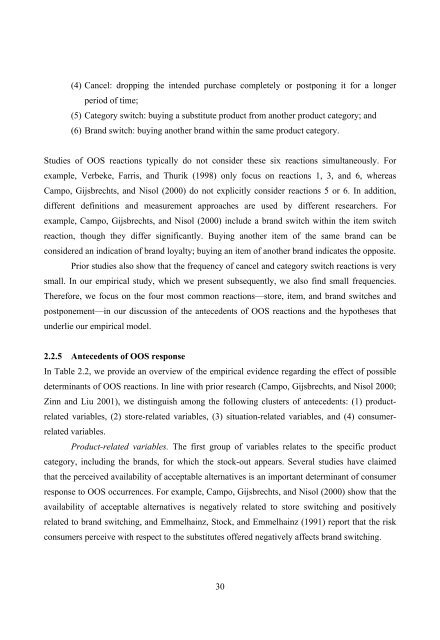Understanding Consumer Reactions to Assortment Unavailability
Understanding Consumer Reactions to Assortment Unavailability
Understanding Consumer Reactions to Assortment Unavailability
Create successful ePaper yourself
Turn your PDF publications into a flip-book with our unique Google optimized e-Paper software.
(4) Cancel: dropping the intended purchase completely or postponing it for a longer<br />
period of time;<br />
(5) Category switch: buying a substitute product from another product category; and<br />
(6) Brand switch: buying another brand within the same product category.<br />
Studies of OOS reactions typically do not consider these six reactions simultaneously. For<br />
example, Verbeke, Farris, and Thurik (1998) only focus on reactions 1, 3, and 6, whereas<br />
Campo, Gijsbrechts, and Nisol (2000) do not explicitly consider reactions 5 or 6. In addition,<br />
different definitions and measurement approaches are used by different researchers. For<br />
example, Campo, Gijsbrechts, and Nisol (2000) include a brand switch within the item switch<br />
reaction, though they differ significantly. Buying another item of the same brand can be<br />
considered an indication of brand loyalty; buying an item of another brand indicates the opposite.<br />
Prior studies also show that the frequency of cancel and category switch reactions is very<br />
small. In our empirical study, which we present subsequently, we also find small frequencies.<br />
Therefore, we focus on the four most common reactions—s<strong>to</strong>re, item, and brand switches and<br />
postponement—in our discussion of the antecedents of OOS reactions and the hypotheses that<br />
underlie our empirical model.<br />
2.2.5 Antecedents of OOS response<br />
In Table 2.2, we provide an overview of the empirical evidence regarding the effect of possible<br />
determinants of OOS reactions. In line with prior research (Campo, Gijsbrechts, and Nisol 2000;<br />
Zinn and Liu 2001), we distinguish among the following clusters of antecedents: (1) product-<br />
related variables, (2) s<strong>to</strong>re-related variables, (3) situation-related variables, and (4) consumer-<br />
related variables.<br />
Product-related variables. The first group of variables relates <strong>to</strong> the specific product<br />
category, including the brands, for which the s<strong>to</strong>ck-out appears. Several studies have claimed<br />
that the perceived availability of acceptable alternatives is an important determinant of consumer<br />
response <strong>to</strong> OOS occurrences. For example, Campo, Gijsbrechts, and Nisol (2000) show that the<br />
availability of acceptable alternatives is negatively related <strong>to</strong> s<strong>to</strong>re switching and positively<br />
related <strong>to</strong> brand switching, and Emmelhainz, S<strong>to</strong>ck, and Emmelhainz (1991) report that the risk<br />
consumers perceive with respect <strong>to</strong> the substitutes offered negatively affects brand switching.<br />
30

















